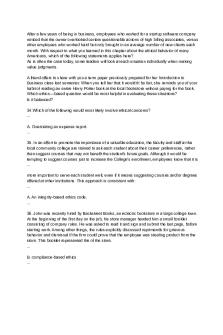M5 - Professor: James Kahl PDF

| Title | M5 - Professor: James Kahl |
|---|---|
| Course | Music & Film |
| Institution | University of Wisconsin-Madison |
| Pages | 3 |
| File Size | 43.4 KB |
| File Type | |
| Total Downloads | 73 |
| Total Views | 160 |
Summary
Professor: James Kahl...
Description
lento slow Image: lento largo very slow Image: largo allegro fast Image: allegro presto very fast Image: presto 00:02 01:33 Upgrade to remove ads Only $2.99/month Meter the way in which lines of music are divided into rhythmic units (think of measure); grouping of beats Image: Meter Articulation the way notes are separated or blended together within a rhythm; may be described by staccato or legato Image: Articulation Staccato beats/notes are distinct and separate; reminder: smoke "stac" on a train (puff, puff, puff) Image: Staccato Legato beats/notes are flowing into each other Image: Legato Timbre unique sound produced by a specific instrument or voice Image: Timbre Traditional Instruments (categorized into what four categories?)
String, Wind (woodwind or brass), Percussion, Keyboard Image: Traditional Instruments (categorized into what four categories?) Texture the overall sound quality of a piece, affected by how voices are, or are not, combined Image: Texture What types of textures? Monophonic, Polyphonic, Homophonic, Heterophonic Image: What types of textures? Monophonic one voice (melody) without accompaniment Image: Monophonic Polyphonic Multiple voices, each with an independent voice (melody) Image: Polyphonic Homophonic Multiple voices, one leading, and the others forming a background accompaniment Heteorphonic Multiple voices perfoming same melodic line with slight variations; see in Asian Dynamics the softness or loudness of a sound in terms of volume Image: Dynamics forte loud Image: forte piano soft Image: piano Structure the overall way a piece of music is arranged Image: Structure Basic Techniques for Teaching Music 1) Activities that involve simple, easy-to-learn instruments (ex: drum & xylophone); drums for teaching rhythm & xylophone for teaching pitches & basic melodies
2) Easy-to-remember lyrics with limited range requirements (lowest to highest note) 3) Activities that offer opportunities for children to physicalize the music (using your body to express the music that is being sung/played) Music Notation Elements of music that is represented symbolically ESSAY QUESTION: Why would this [piece] be a good beginning music exercise for children? ... Time Value the duration for which a note or rest is held; the denominator at the beginning of a measure tells you how many beats a whole note gets Whole Note Represents 4 beats Image: Whole Note Half Note Represents 2 beats Image: Half Note Quarter Note 1 beat Image: Quarter Note Eighth Note Image: Eighth Note...
Similar Free PDFs

M5 - Professor: James Kahl
- 3 Pages

M8 - Professor: James Kahl
- 2 Pages

M3 - Professor: James Kahl
- 2 Pages

M16 - Professor: James Kahl
- 2 Pages

M12 - Professor: James Kahl
- 2 Pages

T8 - Professor: James Grecco
- 3 Pages

B4 - Professor: Terry James
- 2 Pages

T15 - Professor: James Grecco
- 2 Pages

B5 - Professor: Terry James
- 2 Pages

T16 - Professor: James Grecco
- 4 Pages

T3 - Professor: James Grecco
- 2 Pages

Hausarbeit M5
- 10 Pages
Popular Institutions
- Tinajero National High School - Annex
- Politeknik Caltex Riau
- Yokohama City University
- SGT University
- University of Al-Qadisiyah
- Divine Word College of Vigan
- Techniek College Rotterdam
- Universidade de Santiago
- Universiti Teknologi MARA Cawangan Johor Kampus Pasir Gudang
- Poltekkes Kemenkes Yogyakarta
- Baguio City National High School
- Colegio san marcos
- preparatoria uno
- Centro de Bachillerato Tecnológico Industrial y de Servicios No. 107
- Dalian Maritime University
- Quang Trung Secondary School
- Colegio Tecnológico en Informática
- Corporación Regional de Educación Superior
- Grupo CEDVA
- Dar Al Uloom University
- Centro de Estudios Preuniversitarios de la Universidad Nacional de Ingeniería
- 上智大学
- Aakash International School, Nuna Majara
- San Felipe Neri Catholic School
- Kang Chiao International School - New Taipei City
- Misamis Occidental National High School
- Institución Educativa Escuela Normal Juan Ladrilleros
- Kolehiyo ng Pantukan
- Batanes State College
- Instituto Continental
- Sekolah Menengah Kejuruan Kesehatan Kaltara (Tarakan)
- Colegio de La Inmaculada Concepcion - Cebu



